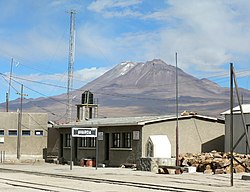Avaroa
| Avaroa | ||
|---|---|---|
 Avaroa train station |
||
| Basic data | ||
| Residents (state) | 48 pop. (2012 census) | |
| height | 3702 m | |
| Post Code | 05-0902-0500-1001 | |
| Telephone code | (+591) | |
| Coordinates | 21 ° 12 ′ S , 68 ° 13 ′ W | |
|
|
||
| politics | ||
| Department | Potosí | |
| province | Nor Lípez Province | |
| climate | ||
 Avaroa climate diagram |
||
Avaroa is a town in the Potosí department in the highlands of the South American Andean state of Bolivia .
Location in the vicinity
Avaroa is the second largest town in the canton of Pelcoya and is located in the district ( Bolivian : Municipio ) San Pedro de Quemes in the province of Nor Lípez at an altitude of 3702 m . The village is the last train station on the Uyuni - Antofagasta line before the Chilean border.
geography
Avaroa is located on the Bolivian Altiplano between the Andes mountain ranges of the Cordillera Occidental in the west and the Cordillera de Lípez in the southeast.
The mean average temperature of the region is just under 8 ° C, the annual precipitation is only 70 mm (see climate diagram Avaroa). The region has a distinctive daytime climate, the monthly average temperatures fluctuate only insignificantly between 4 ° C in June / July and 10 ° C from December to February. Significant monthly precipitation of 30 mm per month only falls in the months of January and February, the rest of the year is almost free of precipitation.
Transport network
Avaroa is 400 kilometers by road southwest of Potosí , the capital of the department of the same name.
From Potosí, the asphalted highway Ruta 5 leads 198 kilometers in a south-westerly direction to Uyuni , from there the partially unpaved Ruta 701 continues to the south-west and after 61 kilometers reaches the bridge over the Río Grande de Potosí . Behind the bridge, a country road branches off in a north-westerly direction and after 36 kilometers you reach the village of Río Grande . From here, the track largely follows the railway line to the southwest and reaches Avaroa after 107 kilometers past the villages of Julaca and Chiguana .
population
The population of the village has remained almost unchanged in the past decade:
| year | Residents | source |
|---|---|---|
| 1992 | . | census |
| 2001 | 49 | census |
| 2012 | 48 | census |
Due to the historical population distribution, the region has a certain proportion of Quechua population, in the municipality of San Pedro de Quemes 24.9 percent of the population speak the Quechua language.
Individual evidence
- ^ INE - Instituto Nacional de Estadística Bolivia 1992 ( Memento from April 23, 2014 in the Internet Archive )
- ^ INE - Instituto Nacional de Estadística Bolivia 2001 ( Memento of February 23, 2014 in the Internet Archive )
- ^ INE - Instituto Nacional de Estadística Bolivia 2012 ( Memento of July 22, 2011 in the Internet Archive )
- ^ INE social data Potosí 2001 ( Memento from December 15, 2011 in the Internet Archive ) (PDF; 5.5 MB)
Web links
- Relief map of the Cerro Araral region 1: 250,000 (PDF; 9.85 MB)
- Municipio San Pedro - detailed map and population data (PDF; 981 kB) ( Spanish )
- Municipio San Pedro - General Maps No. 50902
- Department Potosí - social data of the municipalities (PDF; 5.23 MB) ( Spanish )
